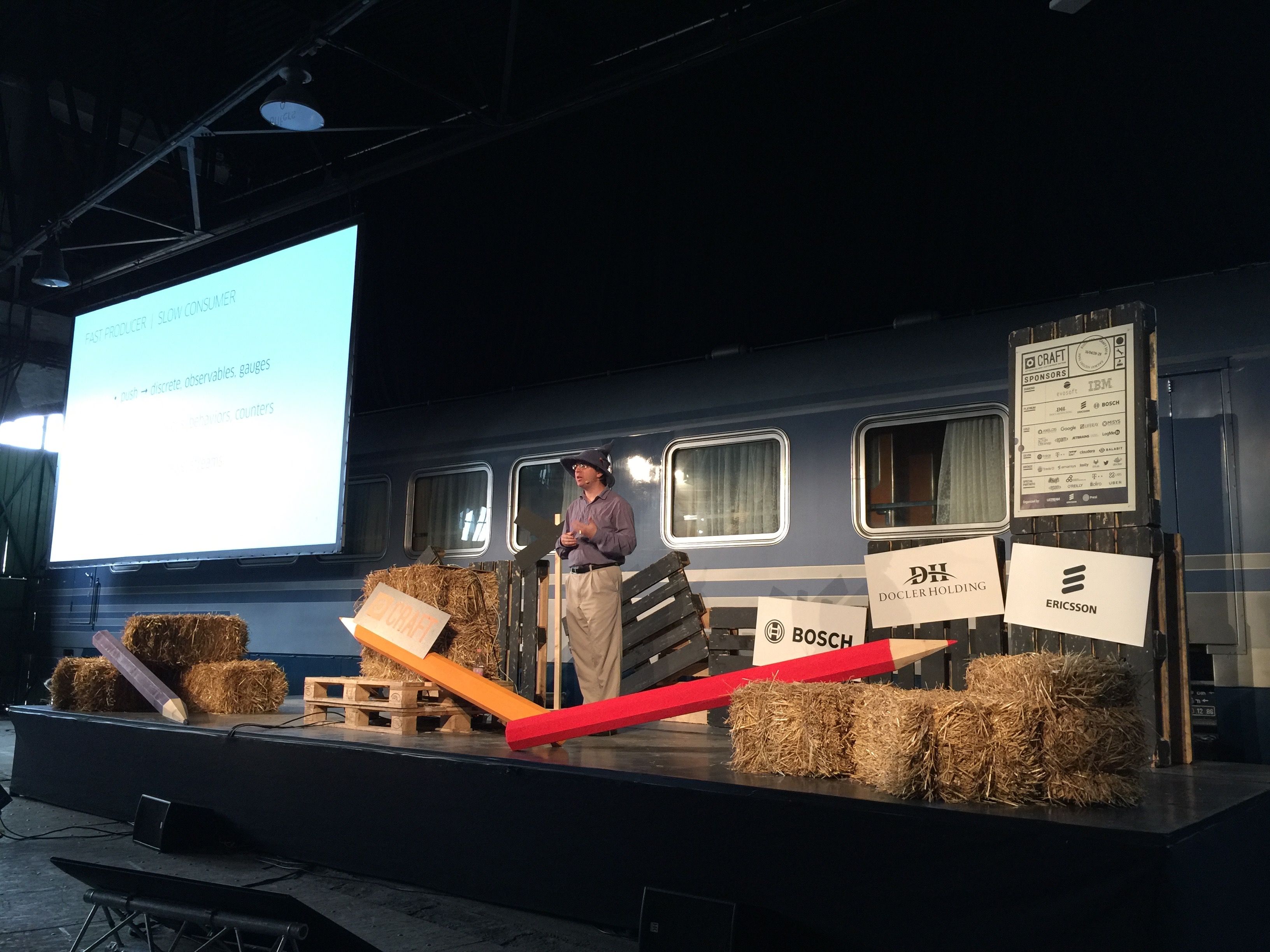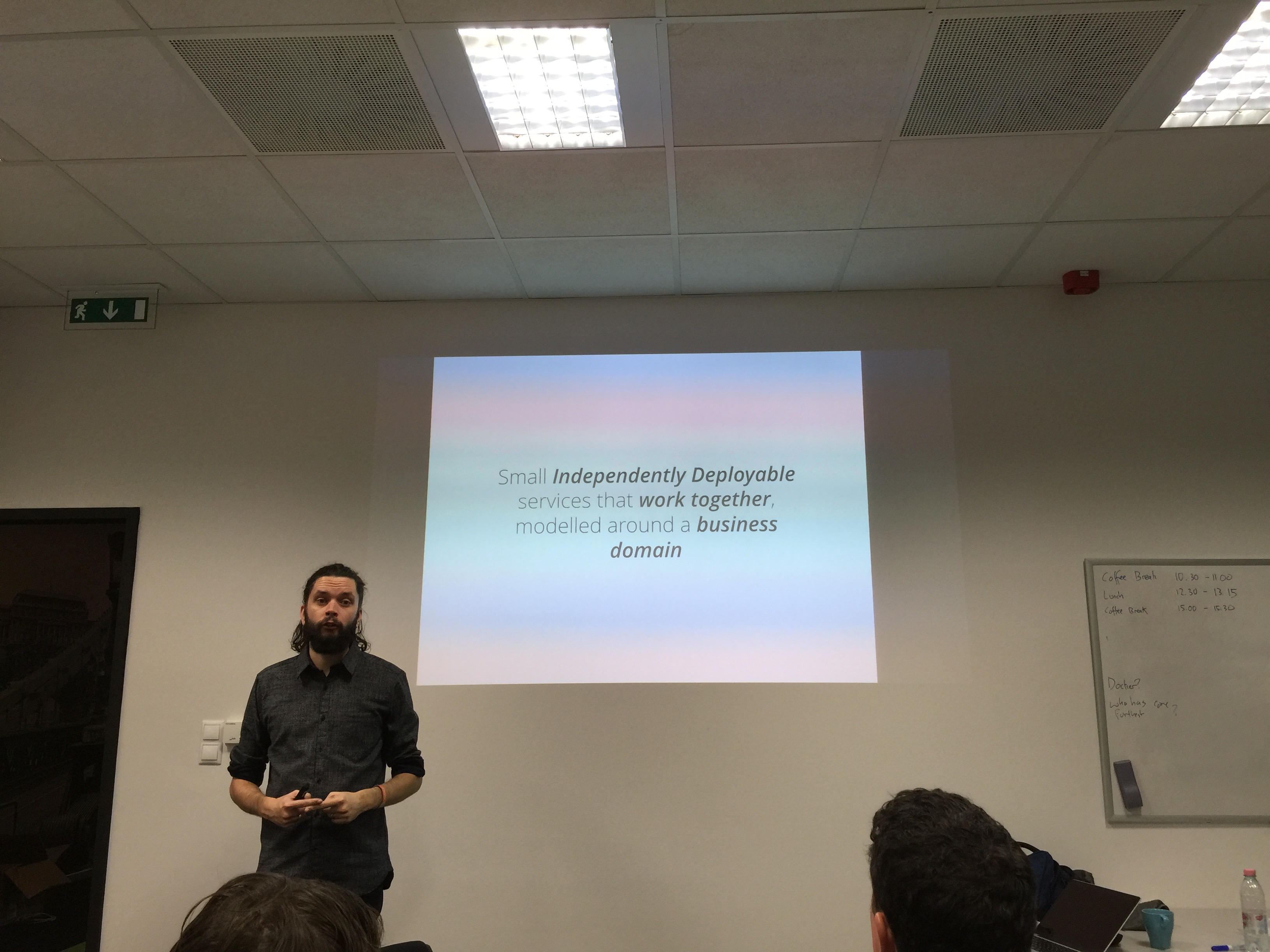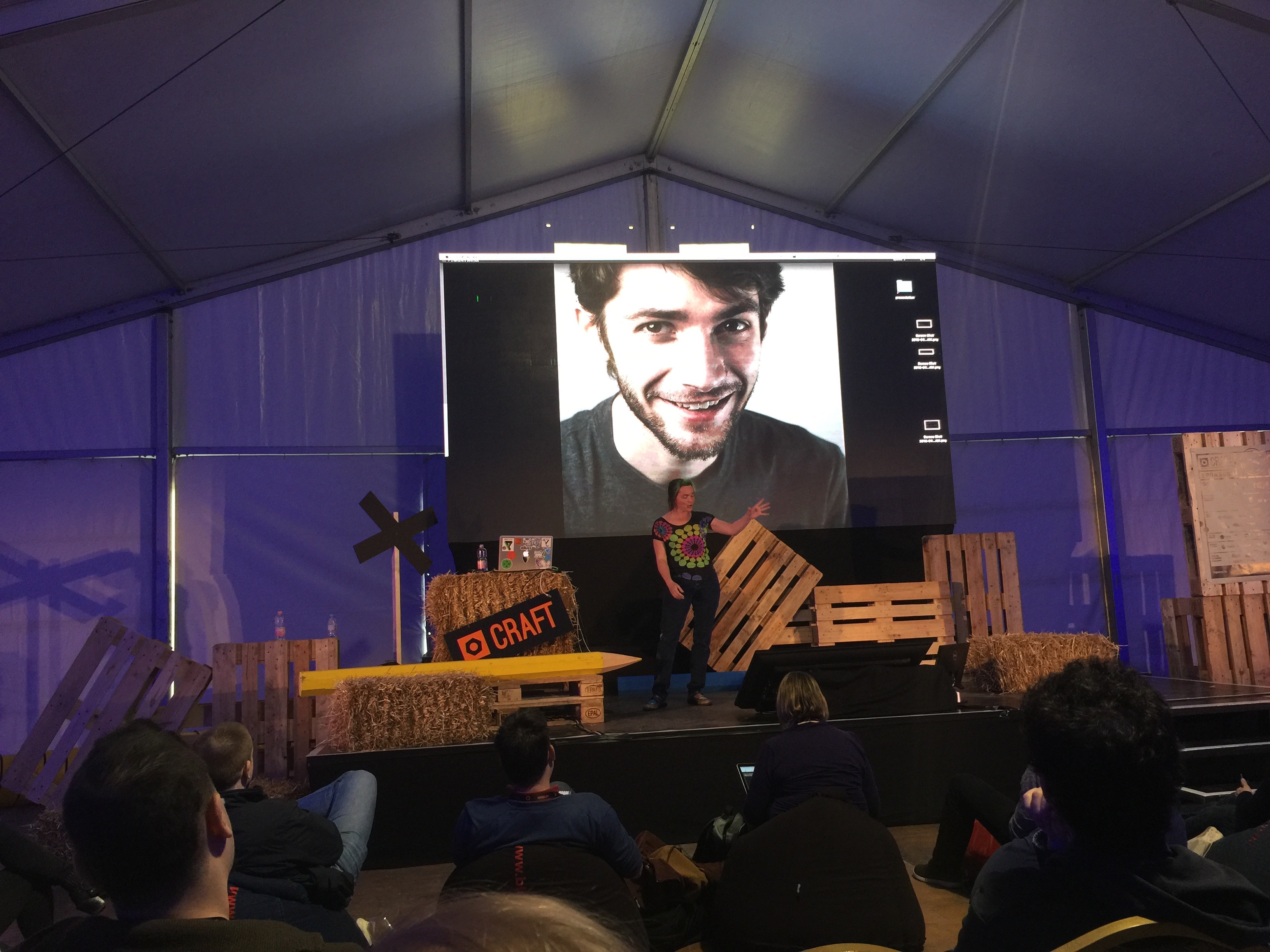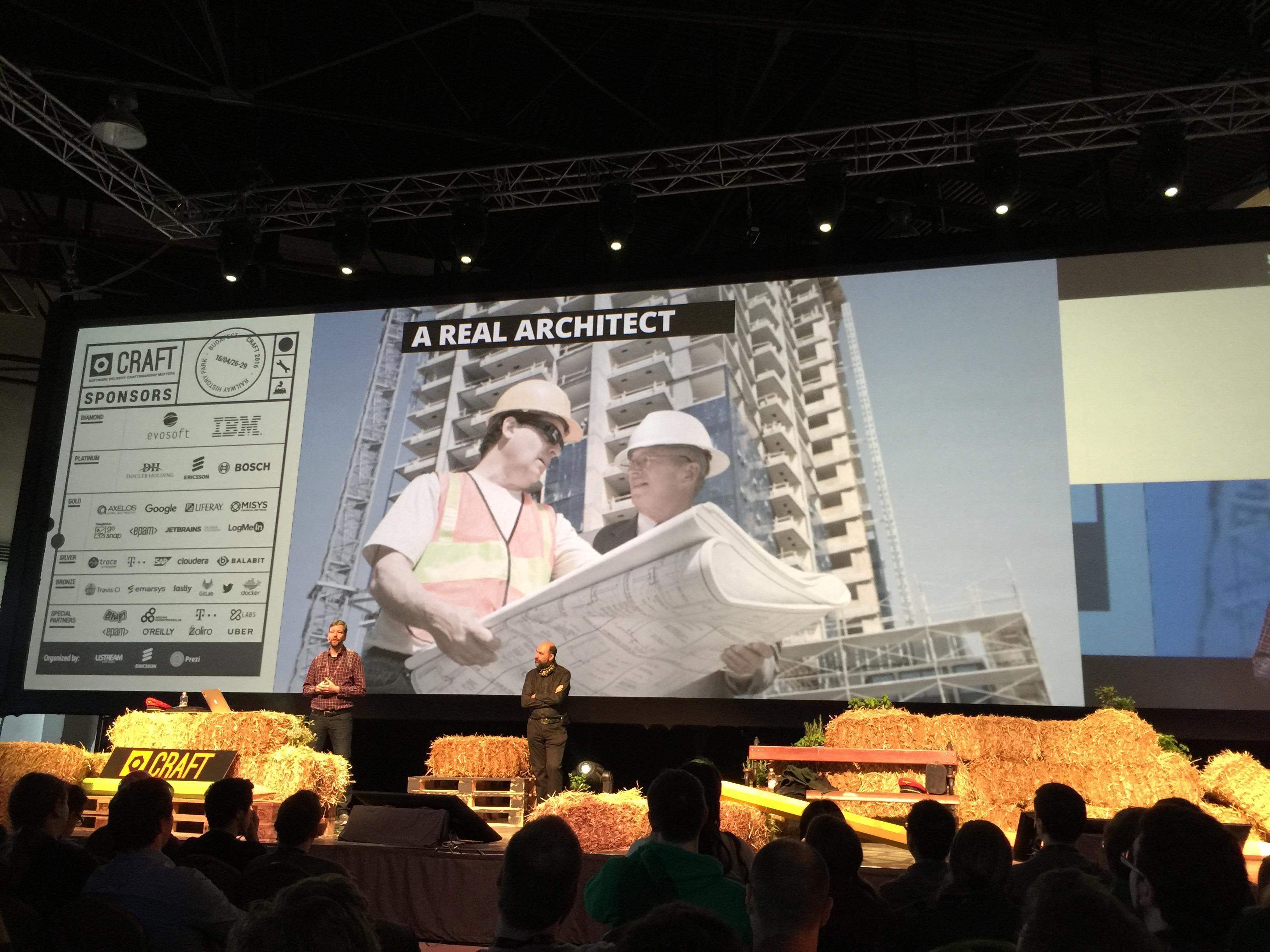Railway to Craftsmanship
by Florjan Bartol · 24 May 2016Maybe “highway” would be more appropriate, since I didn’t take the train to get there. But even so, the pervasive theme of the Craft Conference 2016, which took place between 26th and 29th of April in the beautiful Hungarian capital of Budapest, were trains.
The event took place at the picturesque Magyar Vasúttörténeti Park (Hungarian Railway History Park), which is exactly what you think it is — a big park filled with over a hundred old trains. As you can imagine, it makes for quite a unique conference venue. How to get there, you ask? Hop on the Craft Train, an actual train that takes you from the centrally-located Nyugati Terminal to the venue and back, twice a day. So, rail-heaven.
 Notice the train.
Notice the train.
The conference delivered on other aspects as well (which is especially important for people who are not fanatical about trains). It was well organized, with all the important info sent to us well in advance. For the duration of the conference (i.e. two workshop days and two conference days) the participants were taken good care of with catered breakfasts, lunches and even dinner on some days. Being bored in the evenings was not an option — there were more than 10 meetups on various tech topics, ranging from Docker, agile to functional programming. All these were taking place after the conference schedule ended for the day, followed by a common afterparty at the Google Ground.
But of course, the most important question is: “How was the speaker lineup?”
Speakers
When you hear that the event was taking place somewhere in eastern Europe and not in a western city like London, Paris or Berlin, you just might think that this comes at a cost of a “lesser” speaker lineup. You are so wrong!
The lineup was instead rather impressive — featuring speakers like John Allspaw, Martin Fowler, Marty Cagan and Michael Feathers, to name just a few. Major players in tech space were well covered too — there was no shortage of speakers from companies like Twitter, Uber, Google, Docker and Stripe. Another great fact — 25% of speakers were women. This is quite amazing for such a hardcore dev conference (could be even better of course).
The format of the conference was fairly standard. The first two days were full-day workshops in different locations across Budapest — 11 workshops per day. Followed up with two regular conference days.
Instead of walking you through all the talks I’ve seen, I’ll present the three main topics instead.
Microservices
If I would describe the whole event in one word, it would be “microservices”. If I could use three, it would be “microservices absolutely everywhere”. Microservices seem to be the hottest buzzword at this moment. So of course I attended a lot of these talks to see what all the fuss is about.
Actually, my whole first half of the conference was about microservices because of my workshop selection. The first one, titled simply “Microservices”, was presented by Adrian Cockcroft. “Who is he and why does he think he knows anything about this topic?” Well, Adrian is most well-known for his time at Netflix, where he led the company’s transition to a large-scale, highly-available public-cloud architecture, based on a large number of small services. That was back in the time when Docker and all the modern tools had yet to materialize, so you could think of him as one of the pioneers of the microservices architecture.
Then there was the other workshop by Sam Newman, titled “Building microservices”. Sam works at Thoughtworks and is well known for his recent book Building Microservices. During the workshop, he appeared to be a fun guy with substantial experience on everything about the topic — the workshop itself was half listening to his presentation about microservices and the issues that arise when trying to implement them and half hands-on session with the materials which he shared with us on a USB stick. All this was followed by a long Q&A session where we discussed various topics that were not covered in the material.
 Sam Newman on microservices.
Sam Newman on microservices.
So what about microservices? What are they really? Both workshops gave a slightly different definition. Cockcroft suggested that they are “a loosely coupled service-oriented architecture with bounded contexts”, while Newman’s definition was “small independently deployable services that work together, modeled around a business domain”. Give it some thought and you’ll realize that, both are quite similar. The main takeaway is that all components are independent — i.e. if you have a group of services which you always need to deploy exactly at the same time or things will break, you’re not playing by the rules. The other implication is nicely illustrated by Conway’s law — which basically says that the architecture produced by the organization will reflect the communication structure of that organization.
These properties supposedly provide a nice advantage — in a large organization, individual teams can be more independent and can move much faster — there is never any need to wait for other teams. Each team works in its garden of microservices, uses whatever technology they feel will be the best fit and deploys them at their will. Each microservice also scales independently.
But of course, there are downsides. These can be summed up in just three words: increased operational complexity. For example, monitoring becomes more complex, as you need to monitor tens or even hundreds of services instead of just a few. Integration testing becomes a big pain. The communication between services gets quite complicated. What used to be a simple in-process function call is now made over the network, which is not nearly as reliable. Transactions are much harder in distributed systems. Fortunately, these are all solvable with modern tools. Both workshops gave a good overview of handling these sort of challenges .
Beyond microservices
Cockcroft also talked about his view of the future of microservices. As the trend continues, we will likely transition into what he called “serverless architecture” — an architecture where a unit of deployment is not a microservice, but just a function. An example of this are Amazon’s Lambda functions, which are configured on AWS. When such a function is called, a container is run just for the duration of the call and then shut down again. We explored this at another hands-on workshop by Danilo Poccia - an Amazon evangelist, where he showed how it is possible to build a whole backend for a mobile application by using just Lambdas and other AWS provided tools. Exciting!
Some other talks I attended were by Google’s Kelsey Hightower, demonstrating the use of gRPC and Kubernetes, Docker’s Jérôme Petazzoni showing how to use Docker Swarm in production, and Caitie McCaffrey from Twitter talking about building scalable stateful services. All were great and very informative - with a possible exception of Petazzoni’s talk, but that’s just because I am a Docker beginner and his talk was a bit too advanced for me.
FRP
Another well-represented topic was functional reactive programming, or FRP for short.
One of my favourite talks of the whole conference was Jessica Kerr’s talk about Elm. Elm is a relatively new programming language for building user interfaces, like web apps. Its creator, Evan Czaplicki, is quite an ambitious man — his aspiration is for Elm to be the next big thing in frontend development and to actually replace JavaScript. Sounds crazy? Maybe, but there’s no denying that Elm is an interesting little beast. It is a pure functional language with a very clean syntax (inspired by Haskell) and a strong type system. But fear not — one of its the main design principles is: ease of use. Easy to use, to the point, where developers with very little experience can make meaningful modifications to the code.
 Evan Czaplicki as desktop background image.
Evan Czaplicki as desktop background image.
Elm has very nice properties. For example, if your code compiles, it’s almost guaranteed to work and it will never ever throw a runtime error. Even though you wouldn’t expect it, since it compiles to javascript, it is very fast. It also introduces Elm architecture, which is a very simple pattern to be followed when building programs.
Mrs. Kerr was a great presenter, because of her huge enthusiasm for the language and she also produced a great tutorial.
Culture
Of course, there was no shortage of various culture/product/team organization talks. One of the most interesting, titled Architecture without Architects, was given by Martin Fowler and Erik Dörnenburg. They spoke about the role of architects in software development. They concluded, that they are not very useful. At least not in the traditional sense where an architect is someone who plans a whole software system up-front and hands it to engineers. They argued: while software architecture is usually compared to an actual, construction architecture’s job, it is instead more similar to town planning. The architect’s role should therefore be more about providing a good environment and guidance for engineers, which will ensure that the architecture evolves organically in the best possible way. Or, as Fowler put it: “The most important artifact of an architect are improved developers”.
 Martin Fowler and Erik Dörnenburg explaining why real architects are not a good analogy.
Martin Fowler and Erik Dörnenburg explaining why real architects are not a good analogy.
Charity Majors also produced a great talk on the importance of operations skills for engineers. To build truly effective teams, engineers should have enough operational skills to be able to really own their services end-to-end, including deployment and monitoring. This doesn’t mean that dedicated operations engineers are not required anymore, but simply that developers shouldn’t be ignorant about these aspects. Not owning the mentioned skillset would slow the whole team down. We already expect operations engineers to know how to code and know at least the basics of technologies that will run on our infrastructure, so it should also be the other way around. Majors actually argues that any engineer who refuses to learn these skills should simply not be promoted until he does.
Product
Then there was the great Marty Cagan with a closing keynote on the first conference day. He spoke about what it takes for a team to make a great product. The talk was PACKED with great insights, but let me try to sum them up. A great product team will be composed of all roles: product, UX, engineers, operations etc. On top of those roles the team should be focused on business outcomes. That is, a team should not get a list of features that need to be built, but should instead be given high level objectives/problems, and be empowered to figure out how to solve them. As you can see, this plays nicely with the idea of microservices, where the core idea of team structure is very similar.
The other point Cagan made was the importance of fast discovery. It is considered to be a good practice for the team to function in two separate tracks — discovery (where ideas are validated in form of MVPs as quickly and cheaply as possible) and delivery (where features are actually built and delivered). The important distinction is, that discovery prototypes should be light i.e. not made by engineers, but built with various prototyping tools who don’t require engineering skills to master.
Conclusion
To be honest, when choosing a conference, I didn’t really think of Craft as of much of a contender. But after seeing the impressive list of workshops and talks, I decided to give it a shot. And let me tell you, it was definitely a good choice. Almost all talks I attended were good or even great, the event was very well-organised and quite unique. The entire event was not too commercialized while still having that grand impression of a first class international conference. I may stop at this station again in the future.
